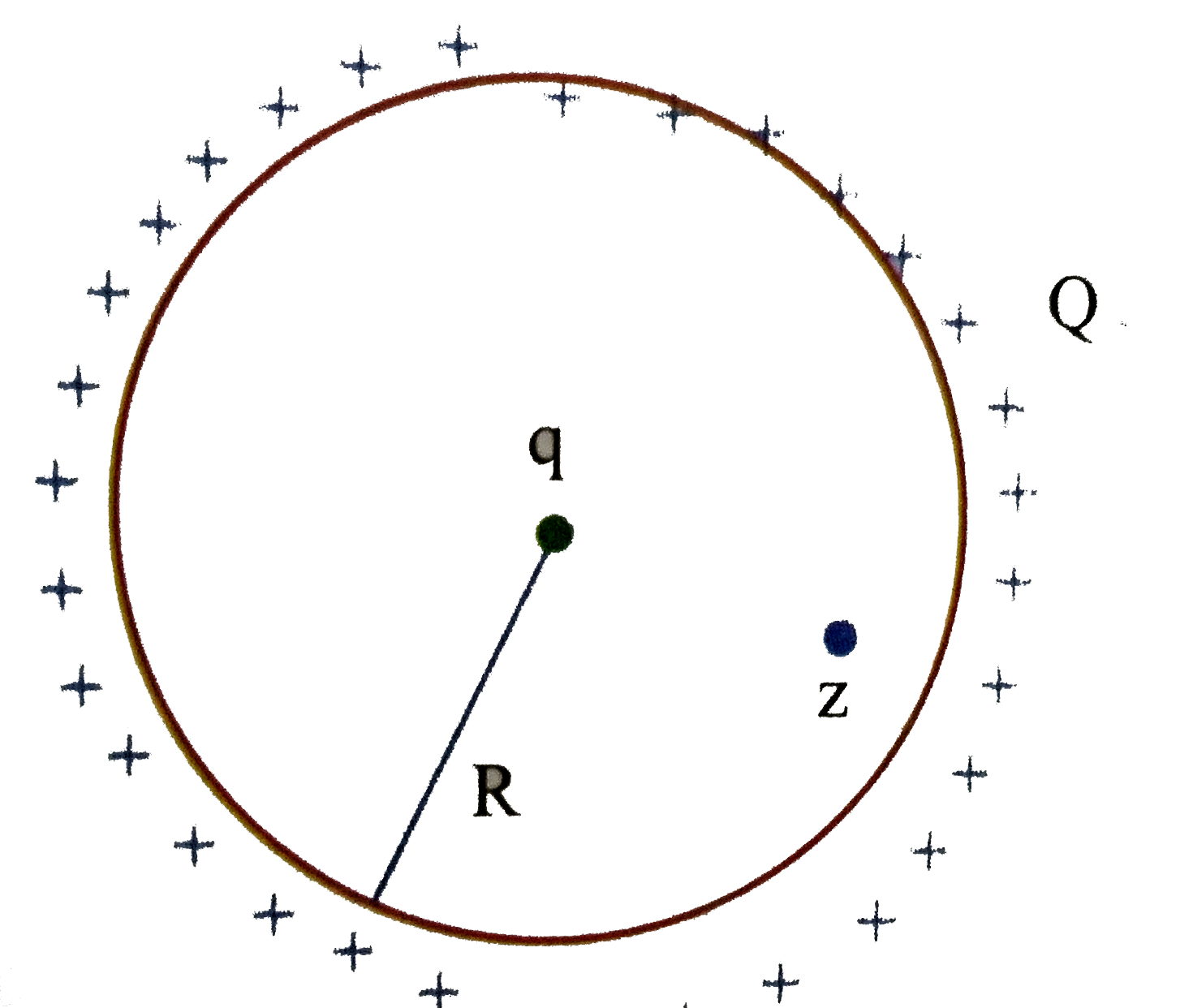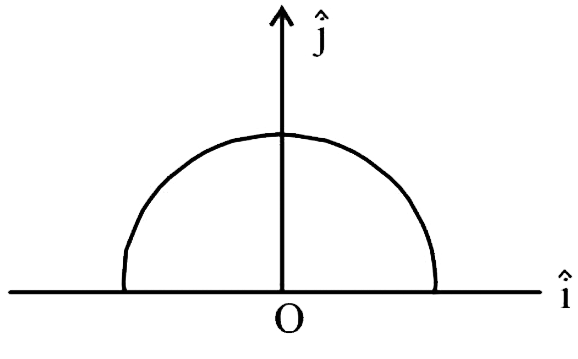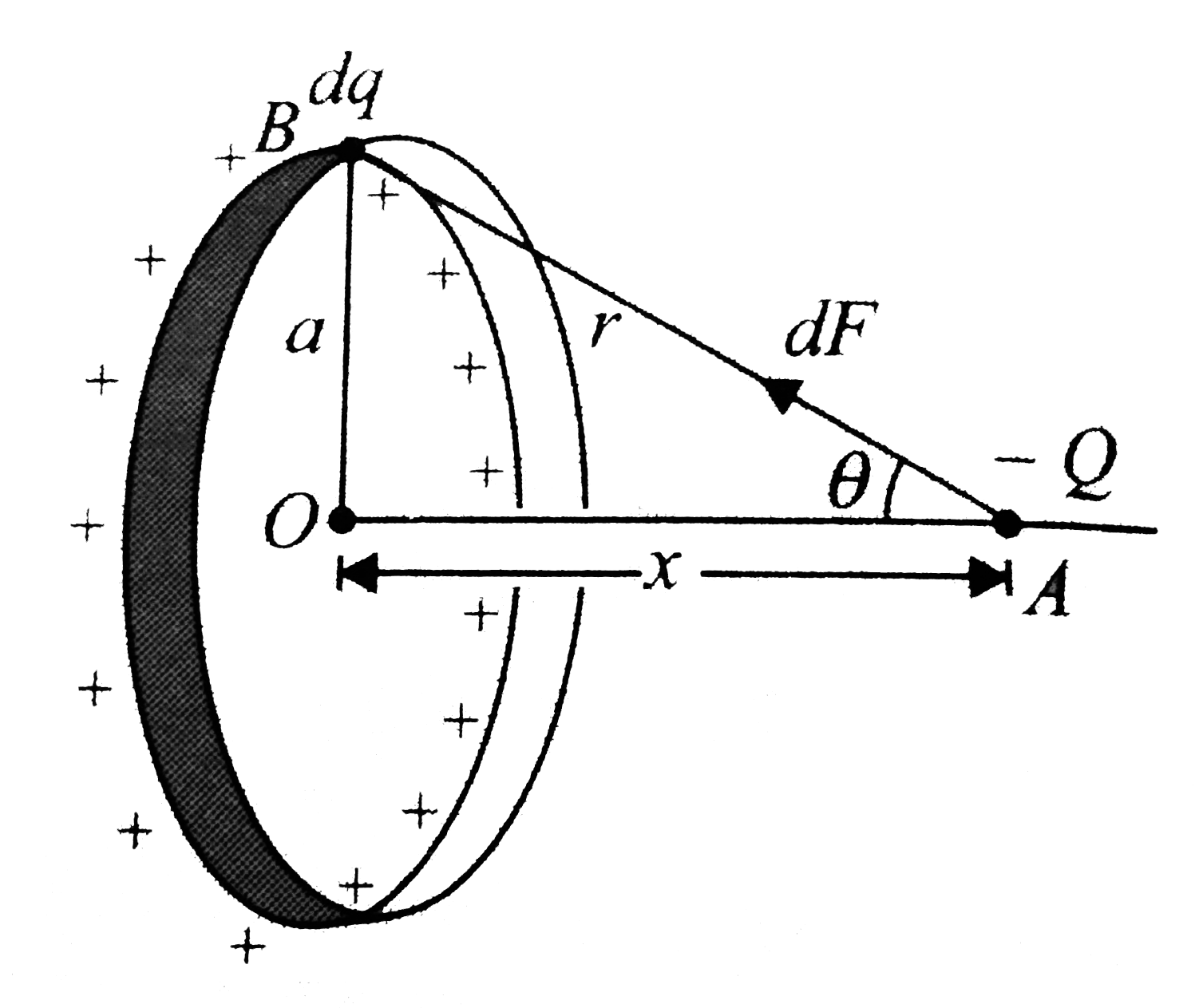A ring of radius R having total charge Q uniformly distributed over the ring has a charge particle q kept at its centre. If a transverse pulse is created on the ring, then find the time when pulse completes one revolution.(Total mass of ring is m)
3πR√QqmRπε0
4πR√QqmRπε0
3πR√πε0mRQq
4πR√πε0mRQq
To solve the problem of finding the time when a transverse pulse completes one revolution on a charged ring with a charge particle at its center, we can follow these steps:
1. Understanding the System:
- We have a ring of radius R with a total charge Q uniformly distributed along its circumference.
- A charge q is placed at the center of the ring.
2. Charge per Unit Length:
- The charge per unit length λ on the ring can be calculated as:
λ=Q2πR
3. Coulombic Force:
- The force acting on the charge q at the center due to a small segment of charge dq on the ring can be expressed using Coulomb's law. The distance between the charge q and the charge dq is R.
- The small charge dq can be expressed as:
dq=λ⋅dL=λ⋅R⋅dθ=Q2πR⋅R⋅dθ=Q2πdθ
4. Net Force Calculation:
- The net force F acting on the charge q due to the entire ring can be derived by integrating the contributions from all segments of the ring. However, due to symmetry, the radial components of the forces will cancel out, and we only need to consider the vertical components.
- The net force can be simplified to:
F=k⋅Q⋅qR2
- where k is Coulomb's constant, k=14πϵ0.
5. Transverse Wave Speed:
- The speed of a transverse wave v on the ring can be expressed in terms of tension T and mass per unit length μ:
v=√Tμ
- The tension T can be related to the net force acting on the ring due to the charge q:
T=F=k⋅Q⋅qR2
6. Mass per Unit Length:
- The mass per unit length μ of the ring is given by:
μ=m2πR
7. Time Period Calculation:
- The time period T for one complete revolution of the wave pulse can be calculated using the relationship between wave speed, wavelength, and frequency:
T=WavelengthSpeed=2πRv
- Substituting the expression for v:
T=2πR
⎷k⋅Q⋅qR2m2πR
- Simplifying this expression gives:
T=2πR√2πmRk⋅Q⋅q
Final Expression:
The time when the pulse completes one revolution is given by:
T=2πR√2πmRk⋅Q⋅q
- We have a ring of radius R with a total charge Q uniformly distributed along its circumference.
- A charge q is placed at the center of the ring.
- The charge per unit length λ on the ring can be calculated as:
λ=Q2πR
- The force acting on the charge q at the center due to a small segment of charge dq on the ring can be expressed using Coulomb's law. The distance between the charge q and the charge dq is R.
- The small charge dq can be expressed as:
dq=λ⋅dL=λ⋅R⋅dθ=Q2πR⋅R⋅dθ=Q2πdθ
- The net force F acting on the charge q due to the entire ring can be derived by integrating the contributions from all segments of the ring. However, due to symmetry, the radial components of the forces will cancel out, and we only need to consider the vertical components.
- The net force can be simplified to:
F=k⋅Q⋅qR2
- where k is Coulomb's constant, k=14πϵ0.
- The speed of a transverse wave v on the ring can be expressed in terms of tension T and mass per unit length μ:
v=√Tμ
- The tension T can be related to the net force acting on the ring due to the charge q:
T=F=k⋅Q⋅qR2
- The mass per unit length μ of the ring is given by:
μ=m2πR
- The time period T for one complete revolution of the wave pulse can be calculated using the relationship between wave speed, wavelength, and frequency:
T=WavelengthSpeed=2πRv
- Substituting the expression for v:
T=2πR
⎷k⋅Q⋅qR2m2πR
- Simplifying this expression gives:
T=2πR√2πmRk⋅Q⋅q
The time when the pulse completes one revolution is given by:
T=2πR√2πmRk⋅Q⋅q
Similar Questions
Charge q is uniformly distributed over a thin half ring of radius R. The electric field at the centre of the ring is
View SolutionA ring of radius 'R' having change 'q' uniformly distributed over it passes through a sphere lies at circumference of ring the centre of ring lies at surface of sphere.Then flux linked with sphere is
View SolutionA charge q is uniformly distributed over a quarter circular ring of radius r. The magnitude of electric field strength at the centre of the ring will be
View SolutionA positive charge Q is uniformly distributed along a circular ring of radius R.a small test charge q is placed at the centre of the ring.
 View Solution
View SolutionA positive charge Q is uniformly distributed along a circular ring of radius R.a small test charge q is placed at the centre of the ring .The
 View Solution
View SolutionA thin semi-circular ring of radius r has a positive charge q distributed uniformly over it. The net field →E at the centre O is
 View Solution
View SolutionElectric charge Q is uniformly distributed around a thin ring of radius a. find the potential a point P on the axis of the ring at a distance x from the centre of the ring .
 View Solution
View SolutionCalculate potential on the axis of a ring due to charge Q uniformly distributed along the ring of radius R.
View SolutionA ring of radius R carries a uniformly distributed charge +Q. A point charge −q is placed on the axis of the ring at a distance 2R from the centre of the ring and released from rest. The particle executes a simple harmonic motion along the axis of the ring. State True or False.
View SolutionA thin fixed ring of radius a has a positive chage q unformly distributed over it.A particle of mass m having a megative charge Q, is placed on the axis at a distance of x(x<<a) form the center of the ring. Show that the motion of the negatively chaged particle is approximatly simple harmonic. Calculate the time period of oscillation.
 View Solution
View Solution

